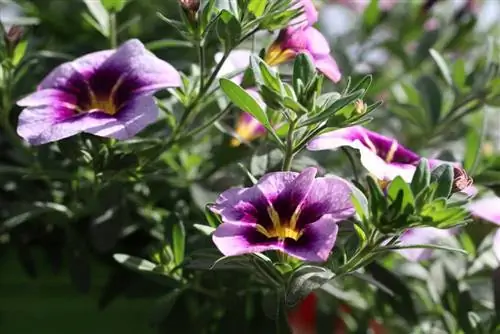- Author admin [email protected].
- Public 2023-12-17 03:39.
- Last modified 2025-06-01 06:48.
Picking means pinching out or cutting off shoot tips, especially on young plants. It promotes bushier growth and encourages branching. We'll show you how to properly remove the sharpening.
How do you sharpen correctly?
- For young plants where the shoots are still soft, it is best to take the fingernails of your thumb and index finger and pinch off the tip of the shoot.
- For thicker shoots, use small but definitely sharp scissors to cut them off!
- With bonsai, regular tweezing of the trees is necessary to maintain the special branches. There are special tools for this.
Which plants are deadheaded?
- SownBalcony box plants - Petunias, geraniums and the like grow significantly bushier and produce many more flowers if they are properly trimmed.
- Perennials - you want to achieve more flowers here too. You can also use it tomove or extend the flower, depending on when the point is removed.
- potted plants - are trimmed so that they branch
- Summer flowers - also become bushier when the tips are removed and simply produce more shoots (dahlias, black-eyed Susans, fuchsias). Plants like fuchsias, where rich branching should be achieved, can be sharpened a little every four weeks.
- Trellis fruit - here, when trimming, all annual shoots that grow from the side buds are shortened.
- Grapevines - Early trimming of the shoots stimulates increased growth of stingy shoots. These shoots must be trimmed again later. This creates a well-exposed leaf mass, which is important for fruit development.
- Tomatoes - is trimmed so that the plants don't grow endlessly upwards and put all their strength into length growth. Pruning occurs when 5 to 6 fruit heads have formed. For greenhouse tomatoes, 7 fruit heads are good.
- Cucumbers - Snake cucumbers are peeled when they are 2 meters high, pickling and peeling cucumbers do not need to be peeled.
What to pay attention to
Prinding is particularly important for plants that are intended to bear fruit later. This includes fruit trees, for example, as well as tomatoes. Another term for de-sharpening is tweezing.
Picking is often necessary, especially for young plants. Nature initially tells them to grow upwards and reach a certain height in order to assert themselves against older plants and secure a location. This natural process is interrupted by de-sharpening. The plant is forced to form new shoots, which then branch out.
Correct trimming is necessary for perennial trees and shrubs in order to lay the foundation for a successful harvest at a young age. It may also be necessary for flowers. A bushy growth habit and lush flowering are also achieved here by deadheading.
You can use your fingernails to trim young, tender plants. Otherwise, use scissors. For older plants you can also use scissors. This can be normal household scissors or, for woody plants, garden or rose scissors.
The sharpening is done to a length of about 4 eyes. The sprouting takes place after the tipping is done from the sleeping eyes underneath.
Conclusion
For many plants it is beneficial if they are trimmed. They grow bushier and produce more flowers. However, you shouldn't sharpen wildly. You always have to think about what you want the plant to look like in the end and how best to go about achieving that.

